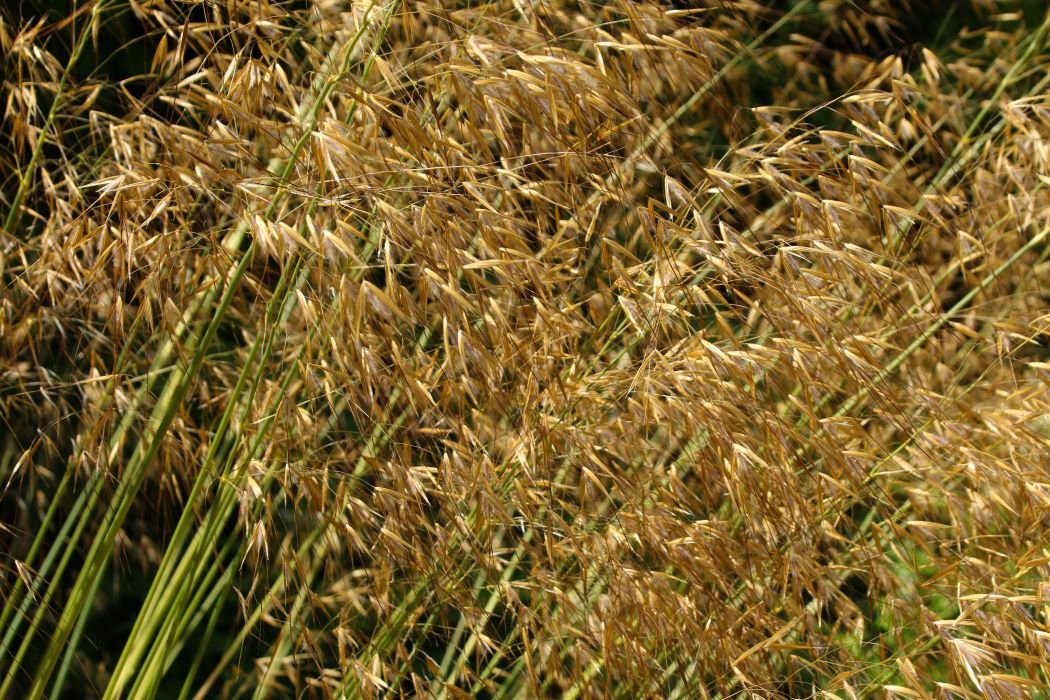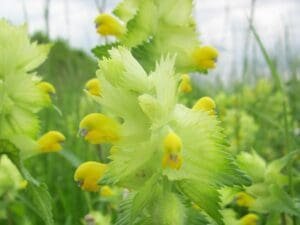Stipa gigantea, commonly known as giant feather grass or giant feather reed grass, is a remarkable ornamental plant that deserves a spot in any garden it inhabits. With its statuesque clumps of arching green foliage and towering, golden-blonde plumes, this perennial grass makes a statement wherever it is planted.
Native to the Mediterranean region, Stipa gigantea thrives in dry, sunny locations. Its gracefully fountain-like form creates beautiful motion and texture. The plumes emerge in late spring and last well into winter, taking on lovely buff tones as they age. Stipa gigantea can grow up to 8 feet tall and wide in ideal conditions.
This drought-tolerant grass is ideal for low-maintenance gardens. Once established, it requires little care and looks attractive year-round. Stipa gigantea works beautifully as a focal point or background plant. It also blends well in borders, rock gardens, cottage gardens, and many other landscaping styles. With proper siting and care, Stipa Gigantea can add elegance and interest to gardens of all sizes.
You might also be interested in: Ornamental Grasses
Stipa Gigantea Care and Planting Guide
Caring for Stipa gigantea is relatively simple, as it is adaptable to a range of conditions. Here is a breakdown of the key factors to consider when planting and maintaining this ornamental grass.
Planting
Stipa gigantea is best planted in spring once the threat of frost has passed. Select a site with full sun exposure to encourage the grass to reach its maximum height and spread. Well-draining soil is a must, as the crown of the plant is susceptible to rot in wet soil. Amend clay soils with compost or sand to improve drainage before planting.
Space Stipa gigantea 2-3 feet apart to allow each clump adequate room to develop. Dig a hole twice as wide and just as deep as the root ball. Carefully place the plant in the hole and backfill with soil, firming it around the base. Water thoroughly after planting. Apply a 2-3 inch layer of mulch around the grass to help retain moisture and suppress weeds.
Watering
Once established, Stipa gigantea is quite drought tolerant and requires little supplemental watering. However, consistent watering is needed for the first year while the root system develops. Provide 1-2 inches of water per week for newly planted grasses.
Signs of underwatering include wilting, browning foliage, stunted growth, and lack of plumes. Overwatering can lead to root rot, indicated by yellowing leaves and collapsing stems. Adjust watering frequency and volume based on the needs of your soil and climate.
Lighting
Full sun is ideal for Stipa gigantea to thrive. Provide a minimum of 6 hours of direct sunlight per day. The foliage will become weaker and thinner if grown in excessive shade. Dappled shade is tolerated once established, but flowering will be reduced.
Soil
Stipa gigantea thrives in lean, sandy, and rocky soils with a neutral to slightly alkaline pH between 6.5-7.5. Heavy clay soils must be amended well to improve drainage. Stipa gigantea is prone to rot if subjected to wet, poorly draining soil. Adding organic material like compost improves both texture and nutrients. Good aeration and porosity are key for healthy root growth.
Fertilization
Apply a balanced, slow-release fertilizer in early spring before growth resumes. Use a low-nitrogen formula, as excess nitrogen can cause flopping and weak stems. Fertilize established plants only every 2-3 years, as Stipa gigantea responds poorly to over-fertilization. Signs of over-fertilizing include excessive foliage growth and reduced flowering.
Stipa Gigantea Design Ideas and Inspiration
With its architectural form and year-round appeal, Stipa gigantea suits diverse landscape settings from refined to naturalistic. Here are some ideas for incorporating this showy grass into your garden design.
Formal Gardens
The structure and elegance of Stipa gigantea makes it an excellent choice for formal gardens. Use it as a dramatic vertical accent in an evergreen hedge or clipped shrub border. Plant in neat rows along straight pathways or geometric beds for a tailored look. Pair it with ornamental grasses like Calamagrostis or Molinia for texture and movement. Stipa gigantea also works well in formal knot gardens encircled by boxwood or lavender.
Informal Gardens
Allow Stipa gigantea to shine as a standout specimen in cottage gardens and more relaxed landscape designs. Underplant it with romantically flowering perennials like roses, phlox and iris. Naturalize it in a wildflower meadow or native grass prairie garden. Use massed groupings of 3-5 plants to create impact. Blend it with billowy grasses or mounding perennials to contrast its strong vertical form.
Containers
The fountain-like shape of Stipa gigantea makes it a wonderful thriller plant for large containers. Choose a 30-inch wide pot as a minimum size for an established specimen. Mix it with cool purple and silver foliage plants like lavender, sage, and Plectranthus. Add pops of colour with annuals like petunias or verbena. Place the dramatic container in a prominent spot on a patio, deck, or in the landscape as a focal point.
Stipa Gigantea FAQs
Here are answers to some commonly asked questions about growing and caring for Stipa gigantea:
How tall does Stipa gigantea grow?
- In ideal conditions, Stipa gigantea can reach heights of 6-8 feet at maturity. Expect an average height of 4-6 feet in most residential gardens.
Does Stipa gigantea need to be trimmed?
- Pinching or cutting back foliage in early spring is optional and will reduce the height. The plumes can be left for winter interest and trimmed down in late winter before new growth emerges.
Is Stipa gigantea invasive?
- This ornamental grass is not aggressive and does not spread invasively when contained within beds or borders. It also does not self-seed readily under cultivated garden conditions.
How does Stipa gigantea spread?
- Stipa gigantea slowly expands in clumps, spreading outward from the crown. Mature clumps can reach 2-3 feet wide but are easily contained. Division every 4-5 years in spring will control spread.
What are the best companion plants for Stipa gigantea?
- Try combining Stipa gigantea with purple coneflower, Russian sage, catmint, Agastache, Sedum, ornamental poppies, Verbena bonariensis, black-eyed Susan, and other full sun perennials.
Final thoughts
With its graceful form and carefree growth habit, Stipa gigantea is a superb ornamental grass that delivers year-round beauty and visual impact. This hardy, low-maintenance plant deserves a spot in gardens of all styles, whether formal or naturalistic. Give Stipa gigantea a try and let its flowing, feathered plumes transform your landscape into a texture lover’s dream. Proper siting, soil preparation and occasional division are the keys to success with this magnificent grass.






